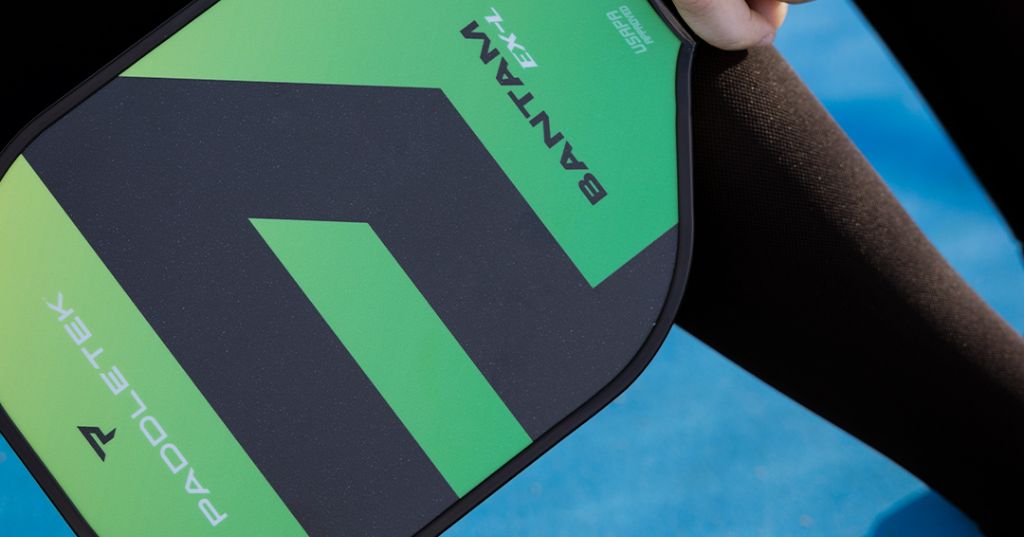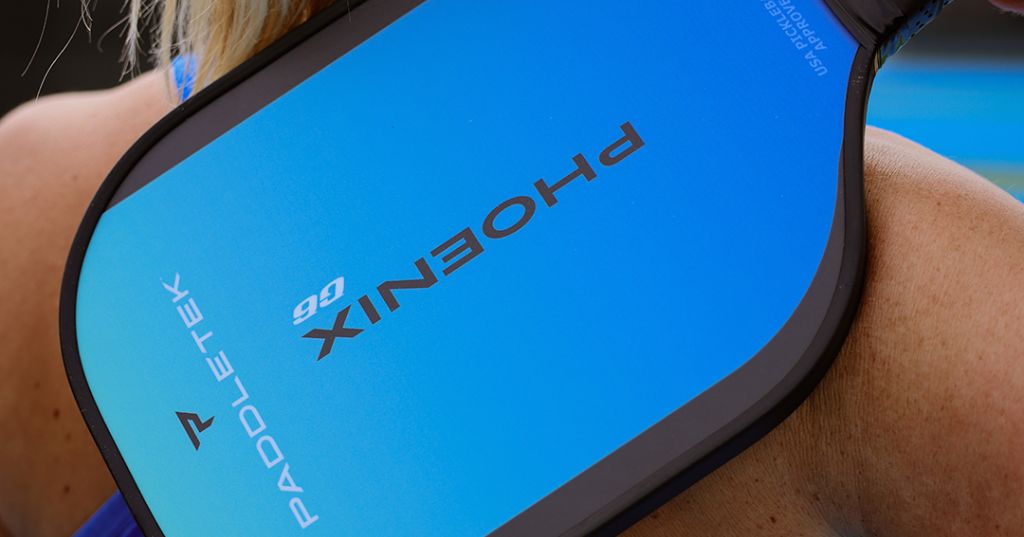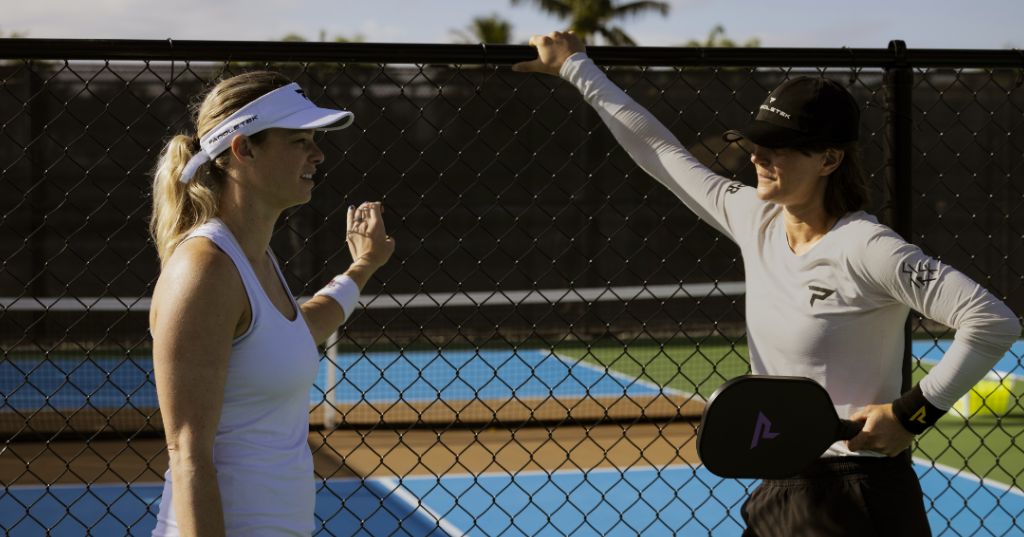Trying to cram in every pickleball rule at once can be tough, but taking the rules one at a time and starting with the basics? Now that’s a solid strategy for understanding the game. What are the basic rules of pickleball to know?
Here are the 8 basics of playing pickleball:
- You can play pickleball singles or doubles
- Only the server scores a point
- The first server is chosen at random, usually by coin toss
- The ball needs to bounce once per side after the serve
- Only underhanded serves are allowed for volley serves
- You have to serve behind the baseline
- The ball has to stay in bounds
- The game ends at 11 or more points
There are far more rules than 8 to master the sport, but if you've never played before, these 8 are the barebones of what you'll need to play a generally proper game of pickleball.
So get ready to jumpstart your pickleball game! We've got the information you need, complete with helpful tips and strategies. Who knows - you may be a pro in no time at all!
What Are the Basic Rules for Pickleball? 8 Rules to Know
Rule #1 – You Can Play Pickleball Singles or Doubles
At any one time, a pickleball court should have no more than four people playing. That’s four if you’re playing doubles, where two teams each have two players. Otherwise, there will be two people on the court in a singles game. Singles pickleball is played one-on-one style.
According to USA Pickleball and its official rules summary, most pickleball games played are doubles rather than singles games.
Doubles pickleball makes the game a bit more beginner-friendly as it reduces the amount of movement on the court, making it easier for you to get to the ball as a beginner. With two people to a side, naturally, you'll need to cover less ground.
Plus, it's always fun to share in the experience, so having a partner on the court as you get familiar with the game is a great way to go.
Whichever you prefer is fine though!
Rule #2 – Only the Serving Side Scores a Point
In pickleball, there are servers–or the ones serving the ball–and receivers, who are the ones sending it back. You can score points only when serving, not receiving.
Using doubles pickleball as an example, one of the two people on the team will be the first server. That player begins on the right side of the court, which is the even side for an even-numbered score of 0 - 0 - Start.
Then they hit the ball to the diagonally opposite side of the court, where their opponent stands. They switch to the left side to serve if they score, then back to the right side if they score again, and so on.
It’s only when the server faults, or makes a rule infraction, that this serving sequence stops. Then the second player on the team serves. If they fault, the ball goes to the other team.
In singles pickleball, once the first fault happens, your opponent gets the ball. They serve until they fault, and then the ball comes back to you.
How is the Word 'Start' in the Score?
You might be wondering how a score has the word start in it like the example above - 0 - 0 - Start - it requires a bit of explanation, but it's not essential for your first game of pickleball. But if curious, keep reading.
In doubles only, there are three numbers called when serving. The serving team’s score is called first, the receiving team’s score is called second, and the final number indicates which server on the serving team’s side is first.
This is known as a server number, where the person serving first on a side is referred to as 1, representing the first server, and the second server is represented as a 2. When a game kicks off, the first server will commonly say Start instead of the typical 1 they would say at other moments of a game.
There are some technical pieces to this as well around the First-Server Exception rule and Start being an alternative for 2, but for your first-ever game, it’s more than enough to know that the first server in a game can refer to their serving order as Start or 2 and after they finish serving it’s considered a side out.
After the first server of a game, serving resumes its normal sequence where each player on each side will serve consecutively.
If you want to know the ins and outs of keeping score in doubles, check out the 10 Essential Pickleball Rules to Learn Before You Play. The second rule on this list goes into further explanation of keeping score, but there are also 9 other rules you might find helpful.
Rule #3 – The First Server Is Determined by a Coin Flip or Other Random Methods
Who is the first one to serve in pickleball? The answer isn't going to make you a better pickleball player, but it's a fun and basic part of the sport that you should at least know about.
Like many sports, the player who serves first in pickleball is decided at random. This can be decided by a simple flip of the coin, where you or your opponent (or the opposing team) will be asked to call heads or tails. Whoever wins the coin toss serves first.
Other options are to spin a paddle instead of a coin or rally for the first point to indicate which side starts.
Rule #4 – The Ball Needs to Bounce Once Per Side
Pickleball has what’s known as a two-bounce rule. If they do this is what it means.
After the initial serve to start the game, the ball has to bounce once before the receiver can hit it. Then the server has to let the returning ball bounce once before they hit it.
The two bounces have to occur on one side of the net apiece. If you let the ball bounce twice before hitting it, that could count as a fault!
Once those two bounces are up, now you can play off the bounce or begin volleying the ball.
The two-bounce rule is only for when you start the game and doesn’t apply at any other point throughout the rest of the game.
You might hear the two-bounce rule called the double-bounce rule. That’s because it went under an official name change a few years back and for good reason.
The term double-bounce means bouncing twice on the same side of the court, which is a fault. Whereas using it for the double-bounce rule means bouncing ones on each side of the court after a serve or else it’s a fault.
You can see the confusion in that, and certainly why USA Pickleball changed the name from double-bounce rule to two-bounce rule.
You’ll hear two-bounce on the courts, and you should call it that too, but in case you hear the double-bounce rule, you’ll now have an idea that it’s an outdated way of saying two-bounce rule.

Rule #5 – Volley Serves Equal Underhand
The migration from tennis to pickleball is a common path for many players. While sharing many similarities, one of the biggest adjustments that tennis players have to make when joining pickleball is how they serve.
In pickleball, there are two types of legal serves; one is far more popular than the other and it can only be legal if done underhand. It's referred to as the volley serve and is the traditional style of serving in the sport.
Here's the gist of a legal volley serve, at the moment the paddle makes contact with the ball:
- Your paddle arm should move upward in an arc-like motion.
- You can’t hit the ball above your waist.
- Your paddle head can’t exceed the height of the highest point of your wrist.
Your serve has to direct the ball diagonally across the court to the side opposite where you’re standing and land in the service area of your opponent. If the ball doesn’t make it far enough - stopped by the net, falls short of the net, or lands in your opponent’s kitchen or on their kitchen line - that’s a fault.
No pressure, but each player gets 1 serve. If you’re the first server in doubles and you fault, the serve automatically goes to your partner, as mentioned. If you’re the second server or you’re playing singles, the serve goes to your opponent in what's referred to as a side out.
Rule #6 – You Have to Serve behind the Baseline
Learn where the baseline is ahead of playing pickleball, as that’s your anchor when serving.
The baselines run the entire width of the court, you can find them at both ends of the court running parallel to the net.
For your serve to be legal, you have to keep both feet behind the baseline and at the moment of serving you have to have at least one of your feet planted to the surface.
Two lines form an imaginary horizontal boundary to the baseline; the centerline in the middle of the court and the sideline marking the outside width of the court. Real or imagined extension, the server can't touch or go beyond both of those lines.
When it's your turn to serve, your best bet is to move toward the middle area between the centerline and the sideline and be about a foot behind the baseline. This will make sure you don't step on the baseline or go beyond its confines.
As you figure out how to serve, you might mess up your foot placement at first. In other cases, your momentum can take you over the baseline, especially if you’re trying a new stance or maybe attempting the drop serve.
Especially early on, it's important to pay close attention to where your feet are.
Rule #7 – The Ball Has to Stay in Bounds
The lines on the pickleball court aren’t only a guideline for serving. They’re also the bounds for both players to follow.
Hitting the ball out of bounds in pickleball is an automatic fault - which shouldn't be all that surprising. Now your partner or opponent gets to serve, and you may cost yourself a point.
Beware of the non-volley zone - which you will most likely only hear called the kitchen. This is a marked area that stretches seven feet from the pickleball net on both sides of the court and runs the width of the court.
If the ball lands in the non-volley zone during a serve, that’s a fault, and this includes the line of the kitchen that separates it from the service court. But feel free to hit in there any other time in the game, in fact, you can be in there whenever you want to, just don't volley in it!

Rule #8 – The Game is Usually Played to 11 Points
Pickleball isn’t a time-based game where after an allotted time, the player with the higher score wins. Instead, the first side to reach 11 points with at least 2 points more than their opponent is the winner.
In tournament settings, the rules might be a little different. Sometimes, this can mean playing either a best 2 of the 3 games at 11 points per game or playing to 15 or even 21.
In non-tournament games, playing to a score higher than 11 is uncommon.
You’ve Got the Basics, Now Build on Them
These 8 components are the bare minimum you would need to know to jump into a game. But now that you’ve got the basics down, you can begin digging deeper into the more complex rules of the game, and there's no better place to start than with the 10 Essential Pickleball Rules to Learn Before You Play.
Keep expanding your pickleball knowledge, but more importantly, get out there and play your first game. That's the quickest way to learn and you'll see firsthand why pickleball is the fastest growing sport in the US.



Leave a comment
This site is protected by hCaptcha and the hCaptcha Privacy Policy and Terms of Service apply.